Vet Med Open House Gives Visitors Up-Close and Hands-On Introduction to Animals, Veterinary Medicine
October 17, 2018

A young visitor gets to get up close and personal with a rat at the Vet Med Open House.
Animal lovers of all ages flocked to the College of Veterinary Medicine on Sunday, October 7, to experience the biggest and best petting zoo around…the annual Vet Med Open House. The event featured myriads of activities ranging from seeing and touching animals, to learning how to care for them, to getting one’s favorite animal painted on one’s face. Most exhibits were staffed by VetMed students who were proud to share with the visitors what goes on in the College, what it’s like to be a student at Illinois, and some of what they’ve been learning as they study to become veterinarians. For the numerous youngsters who showed up with parents in tow, the students hoped to not only inform them and give them a good time, but possibly recruit some future veterinarians into the field.
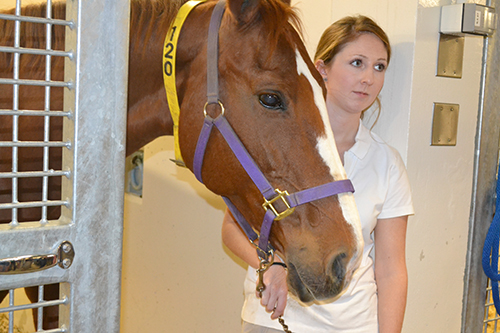
First-year veterinary student Rachel McQuay, who hopes to specialize in equine veterinary medicine, gives visitors a chance to pet a horse.
Visitors got to interact with species ranging from as tiny as a mouse, to as big as a horse. Plus, touching, petting, or even holding animals was the order of the day, whether covered with scales, like Ciara the red-tailed boa constrictor; fur, like Kahn the border collie; or feathers, like the exotic birds from the Wings of Wonder Avian Rescue in Mahomet—a perennial Open House favorite.

Laura Peyton holds Cracker Jack the parrot.
According to Laura Peyton, an officer and volunteer at the avian rescue, the Open House is a win-win, both for the birds and the folks who get to interact with them: “Actually, it gives a lot of exposure to the birds. It gives us an opportunity for people to meet birds. A lot of times they've never touched a bird or held a bird. They've never seen a lot of the species we actually have.”
Peyton also appreciates that the Open House provides her and her colleagues an opportunity to educate the public. For instance, she wants people to realize that birds live a long time, then explains that one of her bird friends, JayCee the Cockatoo, can live 35–40 years, while another species can live 60–80 years. “This big guy over here,” Peyton explains, referring to Cracker Jack, “can live to be a hundred years old or older.”
Peyton shares the various birds’ life-spans in order to stress that owning an exotic bird is a responsibility that’s not to be taken lightly. “It's a long-term commitment with these guys, and that's what we want to let people understand. You can't stick him in a hole someplace and throw in food and water once a week. You have to spend time with them. They're very social animals. You feed and water them every day.”
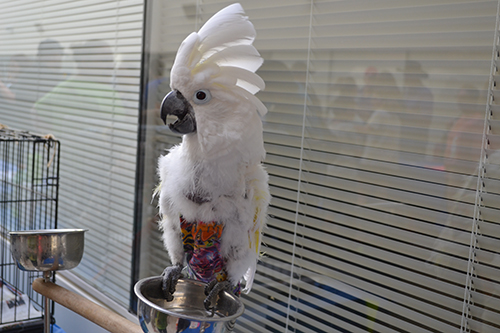
JayCee the Cockatoo.
Another responsibility potential owners should consider is that these birds require specialized veterinarians. While they get fewer diseases than other animals, the vet costs are higher. In fact, because their birds require veterinarians with special veterinary skills, the rescue usually brings them to Illinois’ College of Veterinary Medicine. Plus, in another win-win for both organizations, the rescue also brings their birds to Vet Med a couple of different times throughout the year to help train students, giving them “a chance to handle them, draw blood, do physical exams with them. It gives them the chance to handle them so they have a better idea at what they're doing,” she explains.
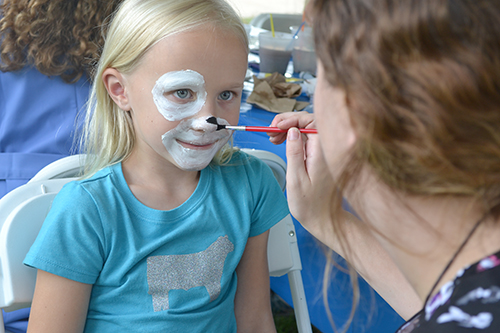
A young visitor gets her face pained at the Vet Med Open House.
Other than Wings of Wonder, most exhibits were staffed by Vet Med students, who hoped to inform the public, plus share their passion for their field with some of the young visitors. For instance, third year Vet Med student John Winter participated in the open house in order to “teach the public about exotic animals,” plus, to “see if there are any interested kids who are looking to go into veterinary medicine and maybe get involved in exotic animals as well.”
Currently doing research at Professor Matt Allender’s Wildlife Epidemiology Lab, his work involves diseases among snakes and turtles. Winter hopes for a career in zoo medicine or wildlife research once he graduates.
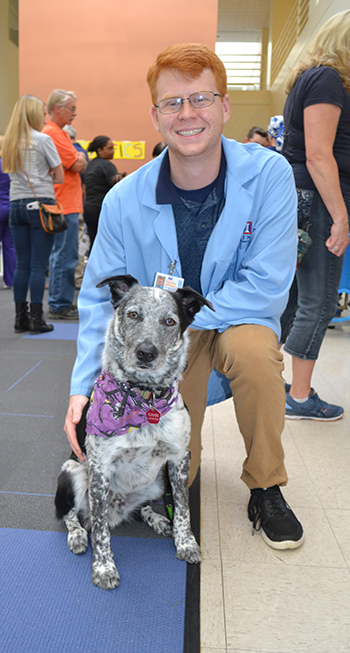
Bennett Lamczyk with Kahn the border collie.
Second year VetMed student Bennett Lamczyk, who was at the event to introduce visitors to his canine friend, Kahn the border collie, says he participated in the Open House because it's a really great way to interact with the public. “I'm here to teach people about how to properly approach a dog and hopefully teach the public how to safely interact with animals, which is really part of the veterinary mission,” he explains.
Though he's only in his second year, Lamczyk has already participated in a two-summer research opportunity at the St. Louis Zoo's Institute for Conservation Medicine, which he says, “was really cool. I worked on a box turtle project there where we analyzed the health of box turtles living within the city of St. Louis.”
While Lamczyk is still in the process of determining what area he wants to specialize in, he is intrigued by the One Health Initiative, a world-wide strategy for combining human medicine, veterinary medicine, and the environment as one approach to improving health. “If we have healthy animals, we have healthy people,” he explains. His dream job would probably be “traveling around to different areas of the world and helping to develop programs in which humans and animals work together for the benefit of the community.”
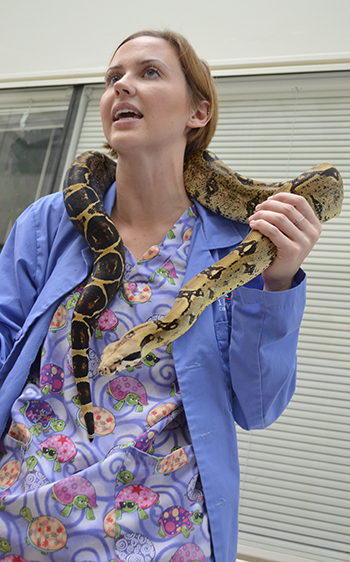
Third year Vet Med student Megan Gramhofer holding Ciara the red-tailed boa constrictor.
Third year Vet Med student Megan Gramhofer was on hand to communicate with the public regarding a species she’s particularly passionate about…snakes. As part of her show and tell, she brought a friend, Ciara the Snake, a red-tailed boa constrictor, for the more intrepid to touch or even pet.
Ironically, Gramhofer admits, “I was actually very afraid of snakes when I was young,” and confesses that the first time she ever touched a snake was during her first year as an undergrad: “I held our Biology Lab's corn snake with my eyes closed for only about 5 seconds. Ha!”
She became really interested in snakes during her freshman summer of undergrad, when she got to do research with the snakes on her school property. “I had always loved other reptiles and amphibians, but snakes—not so much,” she admits. “Through working with them, I got to appreciate how cool and important they were.” That opportunity has fueled her love of snakes, and she’s currently researching snake fungal disease as a member of the Wildlife Epidemiology Lab.
Regarding most folks' (including this reporter's) fear of snakes, she acknowledges that, “It's hard not to be scared of snakes when our culture portrays them in such scary way with movies.” Her advice to help folks deal with their fears is to find out more about them. “I think my biggest pointer is to ask questions,” she advises. “If you know someone who has a pet snake, ask them about it. There are books on why snakes are important to the environment. Education is the most powerful tool.
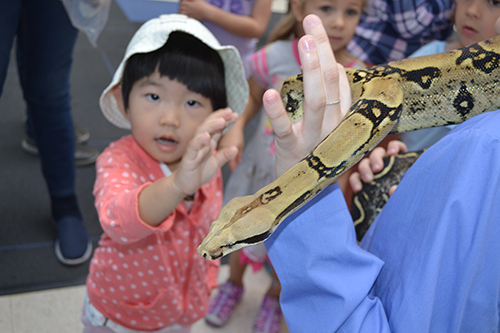
Above: A young visitor gets to touch Ciara the red-tailed boa constrictor.
Below: Megan Gramhofer interacts with young visitors at the Open House.
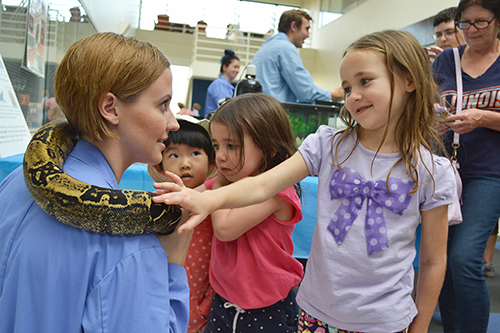
As a snake researcher, she gets excited when people ask her questions about why she loves them. “It gives me an opportunity to tell people the positive impact snakes have on the environment.” For example, snakes keep rodent problems at bay because rodents are their main food source, which in turn also helps keep the tick population smaller, because the ticks live on the rodents that the snakes eat.
A tidbit of info she wanted I-STEM readers to know is this: “Snakes are not there to chase you. Their first instinct is to get away, not to attack. If you leave them be, they won't be a danger to you or your family.”
Gramhofer’s dream job is to work in a practice with large animals, small animals, as well as exotic species (she had to include snakes, of course).
She loves that “Being a veterinarian will give me the opportunity to help people through helping their animals. Being a veterinarian in a practice allows me to help grow the human-animal bond while giving me the privilege to be there for people in a way others can't.”
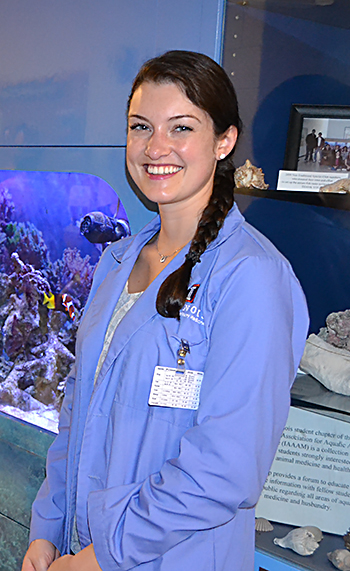
Third year Vet Med student, Chelsea Ciambrone
Third year Vet Med student, Chelsea Ciambrone, Vice President of Illinois Chapter of the Wildlife Disease Association and the Class of 2020 Aquatics Chair, reports that she enjoys participating in the Open House because it provides her the opportunity to share about the species she works with and how important veterinary medicine can be.
According to Ciambrone, she became interested in aquatic animals after participating in a program called MarVet Mexico during the summer after her first year in Vet Med. The focus of the program is to teach veterinarians and veterinary students how to improve the health and conservation efforts of marine ecosystems, which she says encompass both aquatic and terrestrial species that impact local marine life. “MarVet was truly inspiring,” she explains. In fact, it led her to change her career path from equine to aquatic medicine. She shares why she’s passionate about the field:
“To many, giving veterinary care to a fish seems flat out ridiculous. Although I once believed that myself,” she admits, “the more time I spend educating myself about aquatic animals, the more I realize how highly specialized and fascinating they truly are. Not so long ago, the common notion was that animals, such as dogs and cats, don't feel pain or that they have no emotions...who is to say we won't learn and change our predispositions about aquatic animals? Each day, more information is learned about marine species, and hopefully we can take what we learn and practice the best welfare, management, and health care for these species.”
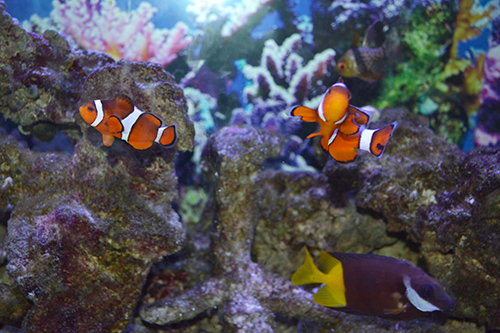
Every aquarium, including the one on the second floor of the VET Med Basic Sciences Building, should have some clownfish—a nod to Nemo and his dad!
Ciambrone’s dream job is to be an aquatic veterinarian at any aquarium—small or large—that participates in whale and/or shark conservation efforts and research.
The scores of visitors who dropped by the Open House came to find out more about animals, personally interact with them, and to expose their kids to them too. For instance, one local woman, Libby Kacich, brought her two daughters to the open house because they both love animals. In fact, her five-year-old, Caroline, actually wants to be a veterinarian when she grows up.
“So she was really excited to come here and see all the animals and see where the students learn how to become veterinarians,” her mom explains. Both Caroline and her little sister, three-year-old Birdie, who also adores animals, have been begging mom for a cat in addition to their dog. In fact, Kacich says that on the way to the open house, Caroline insisted, “Mommy, I think that they let you buy some of the animals," to which mom, of course, gave the classic parental response, "We'll see."

Third year Vet Med student Emma Kamps instructs a young visitor to the model they use at the Veterinary Teaching Hospital to practice intubating patients for anesthesia. In this photo, the local 3rd grader is extubating the patient (removing the tube).
Another local woman, a regular at the VetMed Open House, shares why she brought her kids: “We've been here in years past, and they enjoy sticking their hand in the cow and milking the cow and checking everything out and pretending to be vets.” Did her kids stick their hand in the cow? She reports: “I only had one who actually stuck their hand in the cow,” she reports, but indicates that not only did she and her husband stick their hands in the cow, but, “We got grandma to do it as well!”
Story and photographs by Elizabeth Innes, Communications Specialist, I-STEM Education Initiative.
More: K-12 Outreach, Open House/Expo, Vet Med, Vet Med Open House, 2018
Following is an additional I-STEM article about Vet Med Open House:
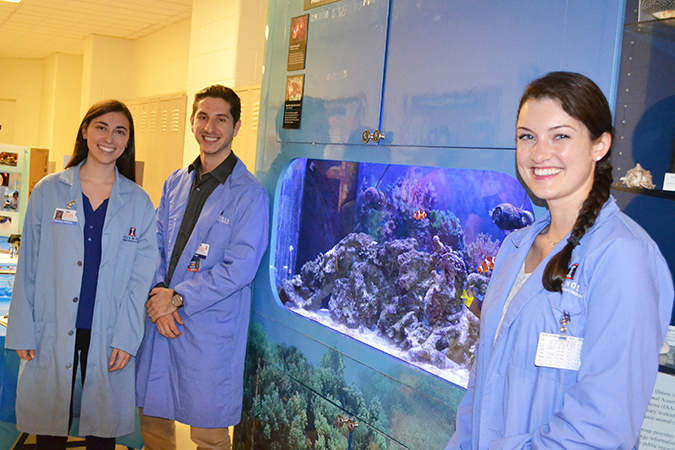
Kathleen Rafferty, Alec Colosi, and Chelsea Ciambrone, who are particularly intrigued by aquatic animals, exhibit the aquatic animals, including the clownfish, in the aquarium on the second floor of Vet Med's Basic Sciences Building.













.jpg)
















